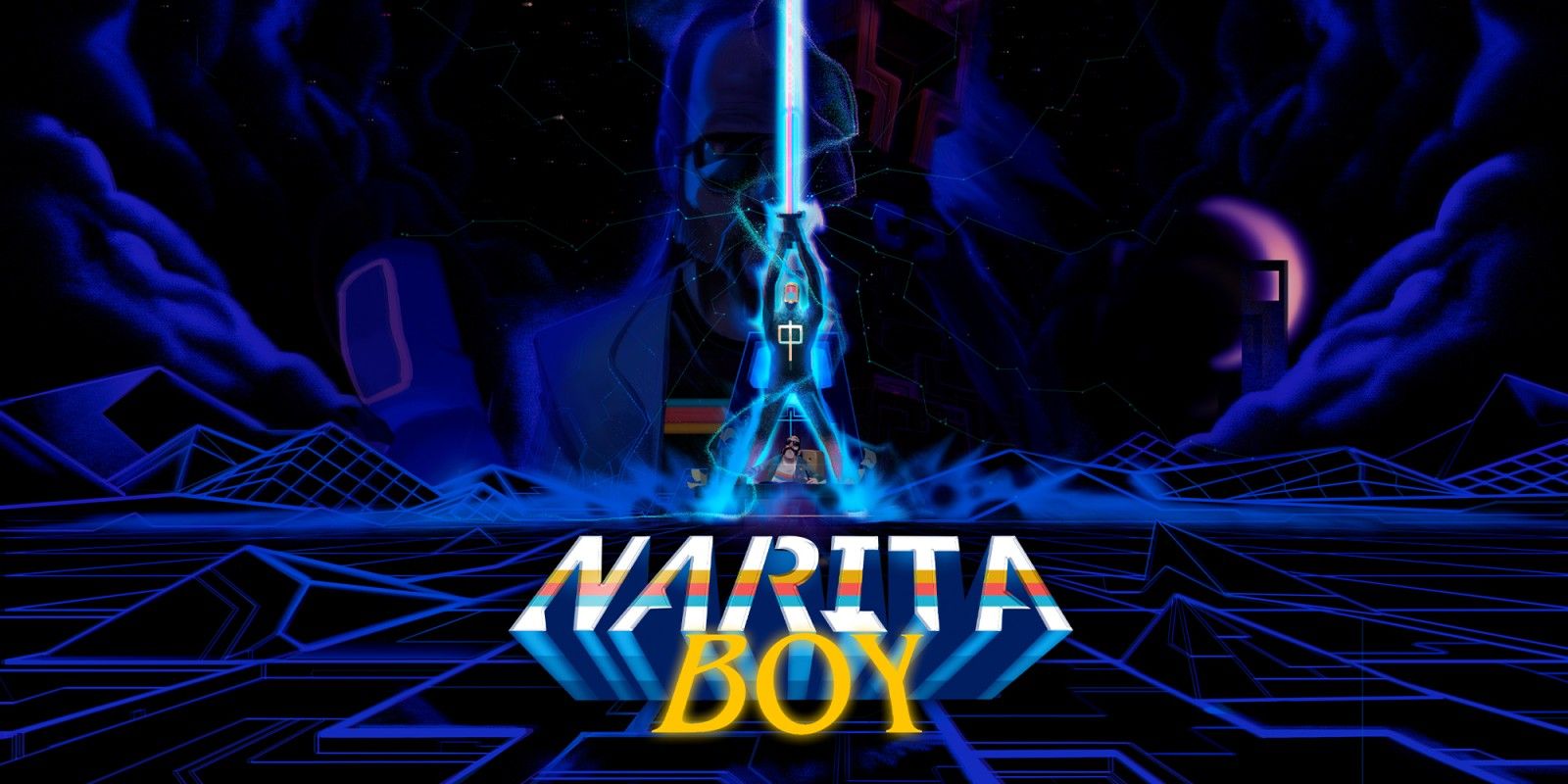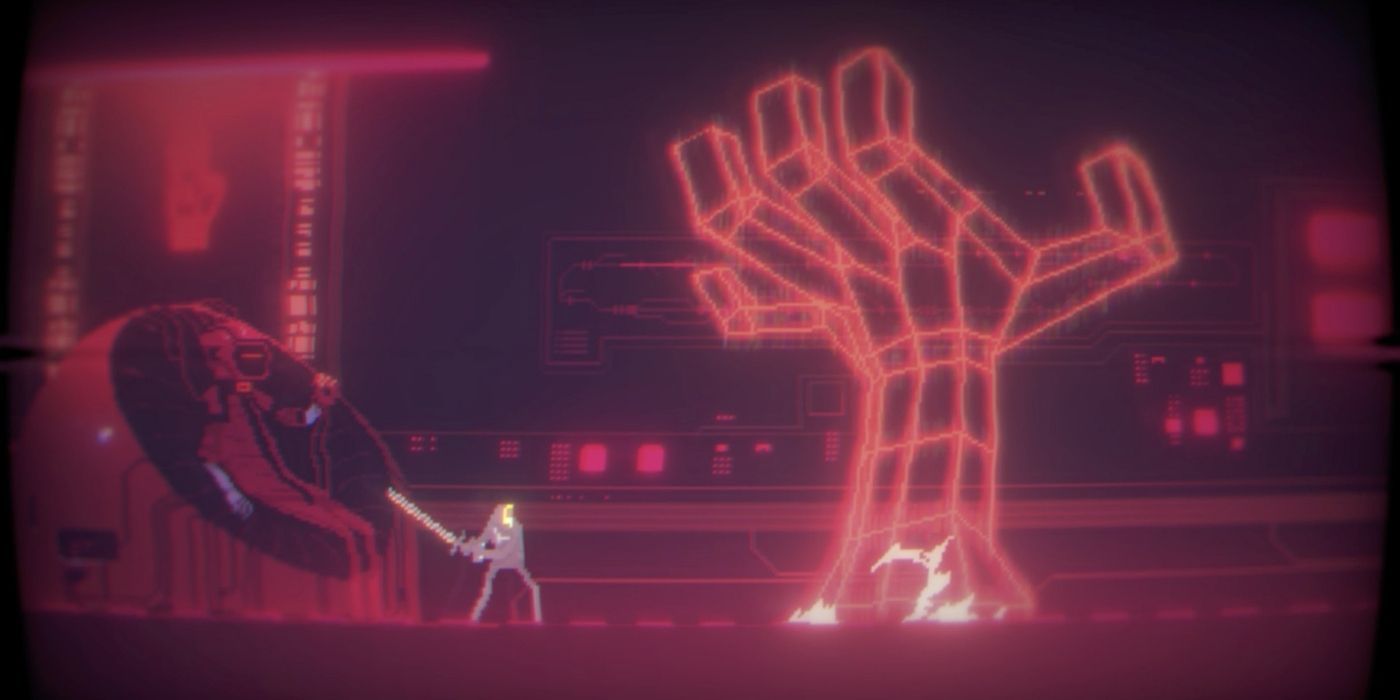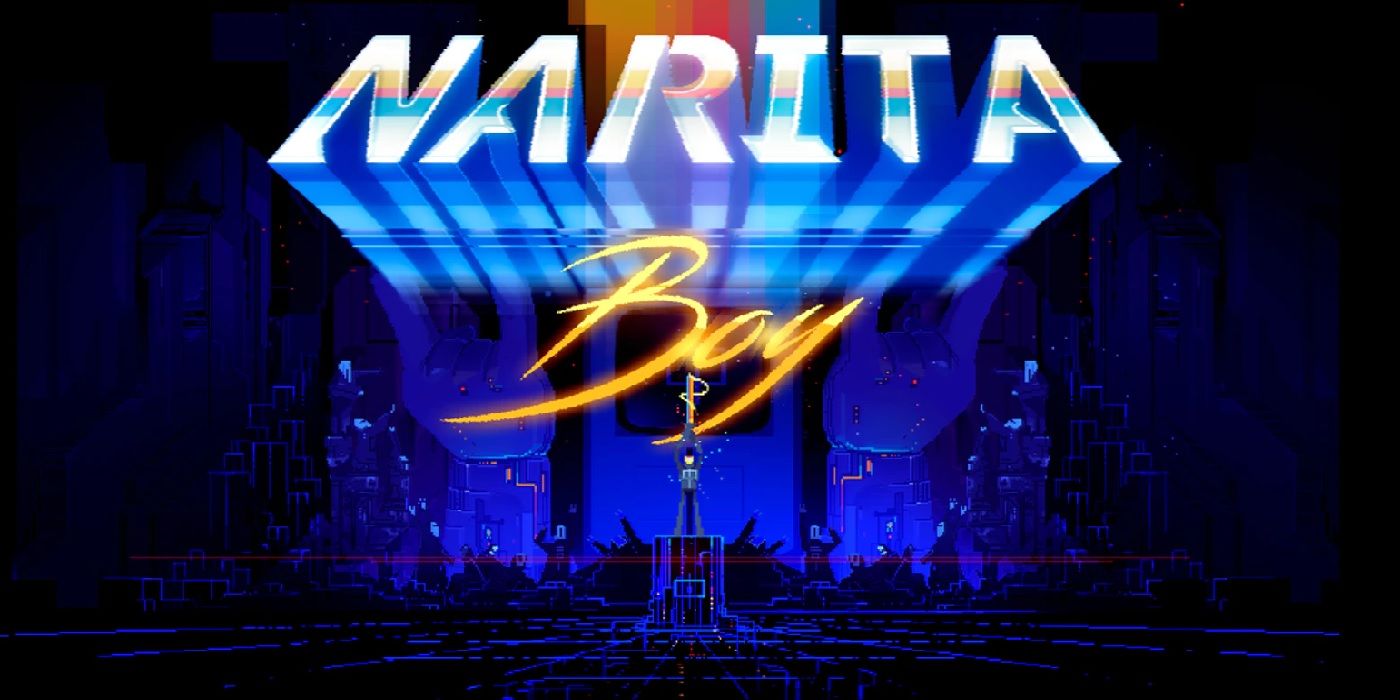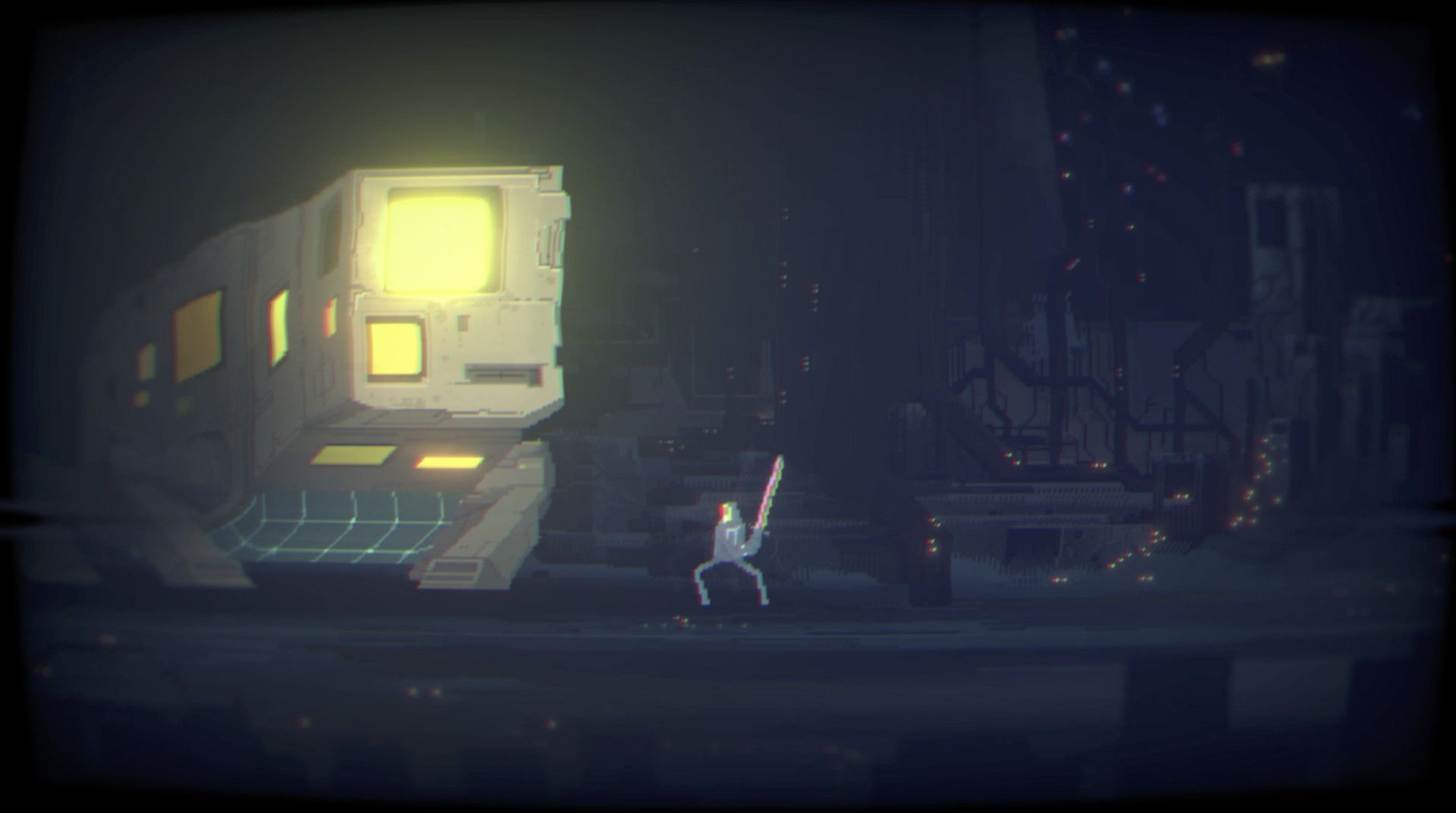In March of 2021, Spanish developer Studio Koba recently launched its first title, Narita Boy: an adventure game that defies neat categorization with its striking pixel visuals, game-within-a-game conceit, and unique synthwave soundtrack. Above all though, the new IP seeks to evoke 80s nostalgia while pleasantly subverting players' expectations.
Narita Boy is already making a splash with critics and indie game connoisseurs alike, and has been met with a reception of "very positive" reviews on Steam. With this, Game Rant interviewed Studio Koba's creative director, writer, and CEO, Eduardo Fornieles, as well Salvador ‘Salvinsky’ Fornieles, Studio Koba's music and FX composer. The following transcript has been edited for clarity and brevity.
GR: In a couple sentences, how would you introduce audiences to Narita Boy?
Ed: It’s a pixel art neo-retro adventure, putting emphasis on a deep narrative, moody and oniric worldbuilding, handcrafted visuals, and a synthwave retro soundtrack.
GR: Looking at Narita Boy’s art and story summaries on Steam, it seems like there is a lot of affection for Tron here. What role did that influence play in developing the game?
Ed: The main influence is the trip inside the computer, and the wireframe - always the wireframe. That old computer feeling! I imagine there is more influence, but not consciously I guess. But Captain N: The Game Master was a very big influence as well.
GR: What other titles and media inspired or influenced your team while creating Narita Boy?
Ed: Captain N, He-Man, Heavy Metal magazine, artists like Moebius, Druillet, Eng, Daft Punk, and the books Ready Player One and Neuromancer. As for movies, the aesthetic of Beyond the Black Rainbow, The Last Starfighter, and many, many others.
GR: Your Steam page mentions the game will feature a mix of action, metroidvania elements, and a narrative-forward experience. Mechanically, what do you think sets Narita Boy apart from other games with similar features?
Ed: What sets Narita Boy apart is the desire to surprise over the gameplay. The way we shape everything - in terms of combat mechanics, visuals, and music – provides constant motivation for the player to keep moving forward.
GR: Narita Boy’s story features a game-within-a-game conceit. Without spoiling too much, can you tease a bit more about what kind of storytelling players can expect from the title?
Ed: It is a game within a game, exactly, but also as a developer we are creating a game, Narita Boy. It is like a mirror facing a mirror. But what the game is about is “the memory.” As Narita Boy you have to help the creator to remember; he has forgotten the code of the game and because of this things inside the game are getting dangerous. So, the storytelling is aiming at that direction.
GR: The game is set in the 80s. It’s often difficult to strike a balance between mechanical novelty and authentic retro style. How would you describe your team’s philosophy in terms of making mechanics feel fresh and relevant, while still capturing the vibe of that time?
Ed: The plot, the premise, the context is very ‘80s. The great themes of empowerment (He-Man), the computer/video game guru designer, the game within the game (Tron, Captain N) – all of these are in there. All these good ideas coming from the ‘80s are our support to start creating our own story and characters.
What we tried to create is a B-side reality where our characters are part of that ‘80s culture, yet beyond all this ‘80s mythomaniac elements we are developing universal themes like childhood and imagination, pain, death, nostalgia, and family. When you finish the game you might not think about the 80s, the cultural references, but instead about the story you just finished, and we hope players keep that story, our game, in their mind for a while.
GR: Are there aspects of game design from the 80s that you think developers have forgotten, or lost track of that should make a comeback?
Ed: There are some aspects of ‘80s game design that we would have liked to include in Narita Boy, but it did not fit in naturally with the core experience.
GR: How would you describe Synthwave to people who are unfamiliar with it, and why did your team choose that aesthetic for Narita Boy?
Sal: I would say that synthwave is music that, when you listen to it, takes you back to the ‘80s. Synthwave is modern electronic music made with sounds and tools that have an ‘80s signature, but a bit different. It is how we see the ‘80s today, how we think ‘80s music would have evolved, or how we would have liked the ‘80s to sound back in the day if we had had modern equipment. And thanks to modern computers you can have at home all the sounds that were popular in the ‘80s!
For me doing ‘80s flavored music is a way of composing music, a way of creating simple and emotional melodies that appeal to people's nostalgia. I don't know if Narita Boy's music is synthwave, or only synthwave - this is for critics to say. What I know is that we decided that the music had to sound pure ‘80s, but more like an OST from a John Carpenter movie than from a modern synthwave artist. Eduardo established a clear rule: synthesizers everywhere, epicness, and the use of the arpeggio. This is a chord played note by note to give this feeling of circularity with mystery (when exploring) or danger (when fighting).
Then for every part of the game there was a particular flavor - Yellow House had to sound baroque and sad, Blue House mystic, and Red House obscure - and from there I had complete creative freedom. We also wanted to appeal to people's nostalgia too. Back in the ‘80s I loved TV theme tunes from Knight Rider, Airwolf, Street Hawk, V (the visitors), and all of them were made with synthesizers. I am also a fan of Vangelis, Isao Tomita, and synth-pop bands from the ‘80s (OMD, Depeche Mode), as well as modern artists with an ‘80s feel (Daft Punk, Deadmau5). So, we put all this in the blender and Narita Boy's OST came up.
GR: How long has Narita Boy been in development, and how has it evolved throughout the process? Any major changes that turned everything on its head?
Ed: We have been developing Narita Boy for four years since we successfully launched our Kickstarter campaign. Because it was our first game, we have found and faced many issues, but we have been learning and thanks to our partner and publisher (Team17) and their advice, we ended up creating the vision we had in mind. Also, the team has been growing to include new members with more experience and skills, making a bigger and solid team. So, little by little we have overcome all those difficulties and now we can say that we are a very strong and unified team ready to keep on making games.
GR: Tell us a little bit about your team. How many people are collaborating on Narita Boy?
Ed: Currently we are six people in the team; very few compared with other productions. There’s myself, Eduardo Fornieles, and I’m Creative Director and CEO. I developed the story of Narita Boy, the script, the game and level design, the visuals, and the animation.
There is also Salvador Fornieles - or Salvinsky as he is known – as the Music and FX composer as well as the Finance Manager (the money guy).
Then we have Chie Wakabayashi as our Office Manager, Kickstarter Communications lead, and Japanese social media person.
Rounding off the team is David Flores, Lead Programmer and Game Designer with Eduardo; Daniel Tomás, Senior Programmer and Combat Designer; and Adrián Chamorro, Senior Programmer and in charge of UI/UX parts. He also coordinated with Salvador to create the proper tools to integrate the FX and audio of the game.
We have had other collaborators, like 2D sprite animator Juan Diez; Copy and Script Editor José Valenzuela; and Sound Engineer David Batalla.
GR: Has COVID-19 impacted the development of Narita Boy in any unexpected or meaningful ways?
Ed: It’s had an impact, as I believe it did for many other developers. By chance, at the time we were locked down in our houses the pipeline and workflow of Narita Boy was solid enough to allow us to keep our schedule and production line in time. The pre-production was done, the tools were done, and the team members could easily work remotely and achieve their daily tasks. Of course, it would be easier working as a team in our office, but by chance it wasn’t as tough as it could have been.
GR: What other challenges have you faced as an indie developer?
Ed: As I said before, developing our first IP is an unknown experience for every member of the team. You think you know how to make games but going from the theory to practice there is a big difference. The worst enemy of an indie developer is where to stop adding content and how to balance all this content. We have had the expertise of Team17 behind us, and that helped a lot to find the best way to solve and sort out all these unexpected issues.
GR: When you aren’t working on Narita Boy, what other games are you and your team currently playing? Are there any fellow indie developers or specific titles you find exciting and inspiring?
Ed: Most of us are big gamers. We have played basically all the new titles landing on all the platforms, but we have a preference for indie titles, not only for supporting them but also because we love indies. To name a few, these include Cuphead, Olija, Enter the Gungeon, Mailmole, Sword of the Necromancer, Loophero, Stardew Valley, Blasphemous, Gris, Overcooked 2, The Escapists, and of course big titles like Cyberpunk 2077.
GR: In terms of post-launch plans, what is in the cards? Are you more likely to expand on Narita Boy or focus on a new project?
Ed: We’ve been focusing on making sure Narita Boy is best it can be for players, but of course, we have one eye on the future.
GR: Is there anything else you would like readers to know about Narita Boy, Studio Koba, or Team17?
Ed: We have a great and professional relation between us. Team17 decided to support us and they have always trusted our vision. They have been very patient and supportive and have never hesitated to offer any help available. From our side, as I said, collaborating with such skilled publishers has helped out to shape the best Narita Boy we could. So thank you very much for always being there, pals.
[End]




